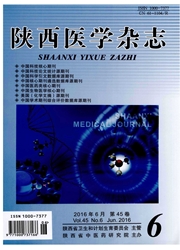

 中文摘要:
中文摘要:
目的探讨急性肾损伤(AKI)在ST段抬高型心肌梗死(STEMI)急诊冠状动脉介入治疗(PCI)患者中的发生情况、预测因素及其对预后的影响。方法连续纳入2011年1月~2013年10月就诊于西安交通大学第一附属医院心血管内科,并接受急诊PCI的STEMI患者,监测围术期肾功能变化,收集临床资料。结果 868例患者中,48例(5.5%)患者发生AKI(AKI组),820例(94.5%)患者未发生AKI(非AKI组)。Logistic回归分析结果显示,年龄≥75岁(OR=3.37,95%CI:1.44~7.89,P〈0.01)、女性(OR=9.48,95%CI:3.96~22.66,P〈0.01)、肌酐清除率〈60 m L/(min·1.73 m2)(OR=6.15,95%CI:2.61~14.48,P〈0.01)、LVEF〈40%(OR=11.08,95%CI:4.59-26.77,P〈0.01)、Killip分级〉1级(OR=12.51,95%CI:5.13~30.54,P〈0.01)是STEMI患者急诊PCI术后发生AKI独立危险因素。与非AKI组比较,AKI组患者住院期间,心血管死亡率、主要心血管不良事件、室速或室颤发生率、心源性休克、主动脉球囊反搏使用率、机械通气、输血、TIMI大出血和TIMI小出血的发生率显著升高(P〈0.05或P〈0.01)。在平均(22±12)个月的随访中,AKI组患者心血管死亡率、卒中、主要心血管不良事件、输血和TIMI大出血的发生率仍显著高于非AKI组(P〈0.05或P〈0.01)。结论 AKI是STEMI患者急诊PCI术后常见并发症,可导致住院和远期不良预后。
 英文摘要:
英文摘要:
Objective To investigate the incidence, predictors and outcome of acute kidney injury(AKI) after primary percutaneous coronary intervention(PCI) in patients with ST-segment elevation myocardial infarction(STEMI). Methods The patients with STEMI undergoing primary PCI admitted in the First Affiliated Hospital of Xi'an Jiaotong University from January 2011 to October 2013 were enrolled. Serum creatinine concentration was measured during the perioperative period. The clinical characteristics were also collected. Results In a total of 868 patients, 48 patients(5.5%) with AKI(AKI group), 820 patients(94.5%) without AKI(non-AKI group). Logistic analysis showed that, age ≥ 75 years(OR= 3.37, 95%CI: 1.44-7.89, P〈0.01), female(OR = 9.48, 95%CI: 3.96-22.66, P〈0.01), creatinine clearance rate 60 m L/(min·1.73 m2)(OR = 6.15, 95%CI: 2.61-14.48, P〈0.01), LVEF 40%(OR = 11.08, 95%CI: 4.59-26.77, P〈0.01), and Killip1(OR = 12.51, 95%CI: 5.13-30.54, P〈0.01) were independent predictors of AKI in patients treated with primary PCI for STEMI. Compared with non-AKI group, the cardiovascular mortality, MACEs, the incidence of ventricular tachycardia/ventricular fibrillation, cardiogenic shock, intra-aortic balloon pump usage, mechanical ventilation, blood transfusion, TIMI major bleeding, and TIMI minor bleeding were significantly higher in patients of AKI group during hospitalization(P〈0.05 or P〈0.01). During a follow-up of(22±12) months, the cardiovascular mortality rate, stroke, MACEs, blood transfusion, and TIMI major bleeding were con tinuously significantly higher in patients of the AKI group than those of the non-AKI group(P〈0.05 or P〈0.01). Conclusion AKI is a common and serious complication among patients with STEMI undergoing primary PCI, which is associated with worse in-hospital and long-term outcomes.
 同期刊论文项目
同期刊论文项目
 同项目期刊论文
同项目期刊论文
 期刊信息
期刊信息
